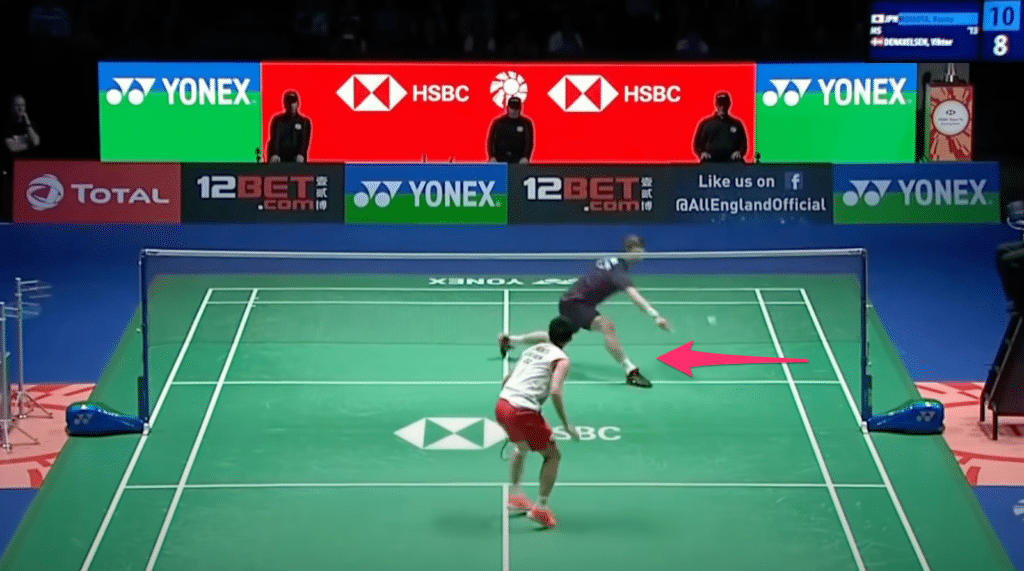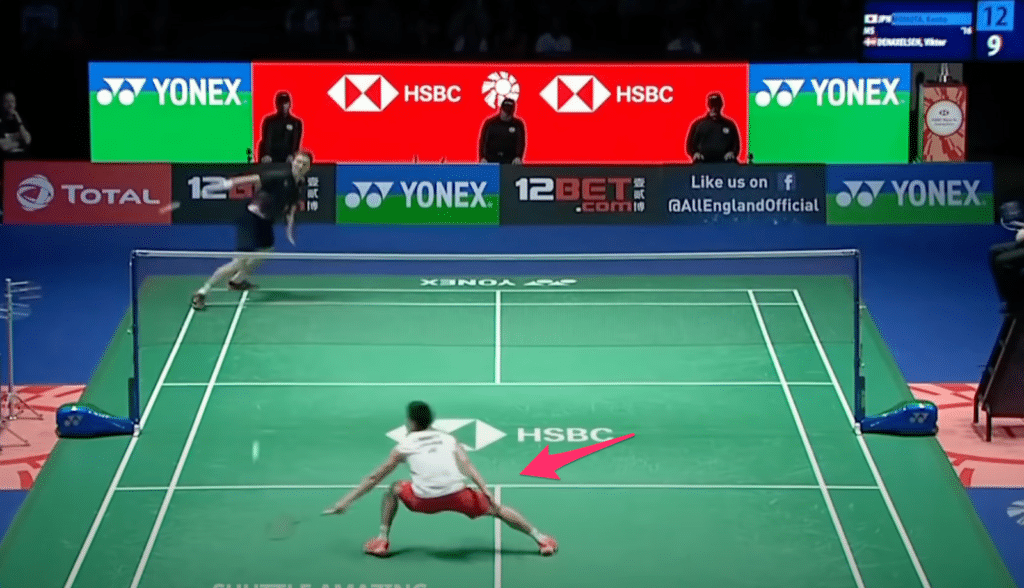How do you attempt to get the shots that land in the corner of the badminton court?
By running as fast as you can, hoping to hit the shuttle before you crash into the net poles at full pace? Or give up and let it cost you a point?
The ideal answer lies behind door number three: using lunges in badminton.
Notice how both Kento Momota and Viktor Axelsen save the shuttle in this clip. If you watch it for less than a minute, you’ll see that both players are performing several different lunge variations, one after the other.


Some lunges are deeper than others and we often use two overarching variations:
- The distinct corner lunge (to each of the corners on the court)
- The sideways lunge (often used to defend a smash)

As we can see, a badminton lunge is a technique that helps us get those hard-to-reach shots and it’s a key ingredient in badminton footwork. It’s the only way to get the shuttle rather than forfeiting the point.
They can be handy in other situations because of how far we are able to extend the arm beyond the lunge itself, as we saw Momota do just now, but they also come with an important downside we’ll discuss later.
Let’s first dive into the kind of shots that go along with the lunge in badminton and how to perform it correctly.
The two shots accompanying a badminton lunge
When we use the lunge, it’s usually to reach a shot below the tape of the net and that means our two main shot options are a net shot or a lift.
The further the shuttle falls below the net, the deeper the lunge we need to perform in order to get it. That makes the return shot more difficult in the front corners as the angle gets steeper and there’s a higher chance of hitting the net. On top of that, it makes it easier for our opponent to anticipate our shot and be ready with a kill if it’s weak.
In singles, players often wait near the middle of the court, slightly closer to the net, as they’ll have less time to react compared to if we lift, even though they’ll have to move all the way to the backline.
The net shot can be either returned on the same side or as a cross shot. In both cases, it requires us to play it tight and close to the net tape to make it difficult for the opponent to return without causing a fault for either touching the net or crossing the racket over the net onto our side of the court.
Now that you have a sense of this little chess game at the frontcourt, let’s get practical with the pro players as they show us how to perform the badminton lunge correctly.
How to perform lunges in badminton as explained by the pros
First, let’s break down the lunge motion itself.
Key points to the lunge in badminton
- Directional split step
- Lunge on your racket leg
- Land heel to toe
- Keep your knees aligned
- Keep your torso and head upright, core strong and legs bent
Next, let’s see how the lunge works sideways and for each of the four corners along.
There are two things to keep in mind as you’re considering when to use a lunge on the court:
- Avoid lunging deep if there are other, faster, movements that make sense in the situation
- Kick-off explosively as you recover after performing the lunge
How to train the lunge on court
The benefit of training lunges on a badminton court is that you’ll build a habit of knowing exactly how far to lunge, and from which position on the court, in order to reach different shots. It’ll become second nature.
However, it can be challenging to find an available court outside of work hours since that’s the only time many other players are available too. A decent alternative is training lunges at the gym or even at home — it’s better to start there if that helps you implement it into your game than not using lunges in badminton at all.
How to train lunges at the gym
Building the muscle to lunge a lot, for endurance and in order to recover explosively, is a great choice as a part of your weekly off-court training routine for badminton strength.
I’ve gathered some clips of training examples here.
Training standard lunges at the gym:
Training side lunges at the gym:
Home training ideas:
I hate to say this but please be mindful that performing the lunge puts our body at risk of injuries, so make sure you’re warmed up well before performing it.
You may even consider forfeiting points in the first few games of your sessions if it requires a very deep lunge in order to make sure your body is ready. The alternative is to win the point body, getting injured and not able to play for months. Not fun.
The problems you’ll encounter when using lunges in badminton
After learning how to use lunges correctly you’ll likely hit a lot of shots in the net until you learn how to calibrate your lift and net shots to the tight angles at the front court. This sucks but there’s a bright side to this.
It’s a great indicator for you that you’re doing something right and improving your game. If you’re able to reach more difficult corner shots than before, you know that it’s a two-part problem and you’ve solved the first one.
Your problem has moved beyond that point and onto the second part: how you best return the shuttle from that position. That’s most of the hard work done.
The badminton lunge might get you stuck
The big problem is that recovering from the lunge is slow, so it’s key to get back out of the corners fast. Your opponent may already know that and use it against you.
Here’s a good example of how my opponents are taking advantage of the slow recovery (and my weak lifts). I’m the one wearing the yellow-black t-shirt on the right hand side.
On the other hand, that also means you can take advantage of it by forcing your opponent into a lunge, knowing that there’s a chance they’ll return a weak shot you can convert into a point.
Specifically, with the badminton lunge, recovery is our biggest chance to be better than our opponent, since many casual players focus on getting the shuttle and stop training the motion following that.
One way to improve our recovery is by side-stepping or chasse-ing more before initiating the lunge, as it can be faster and allow us to get the shot with a standard lunge rather than a particularly deep one.
While playing doubles, if you find it necessary to use a deep lunge but the shot isn’t at the edge of the corner, it may be a sign that you’re not anticipating your opponent’s shot or positioning yourself correctly. This is a bit of a poker game as we can guesstimate the percent chance of the opponent’s shot options and commit accordingly.
For example, in singles, if you play a clear shot to a corner on the rear court, you might be most exposed to a drop or smash down the nearest line or across the court. In that case, it can make sense to position yourself slightly to one side of the center as you anticipate the return, since the shuttle has to travel a shorter distance to hit the floor down the line, meaning that you’d have less time to react.
At the same time, we might notice that our opponent is slightly late to the shuttle and a bit off balance, so there’s a higher chance they’ll play a drop shot. That suggests we may benefit from positioning ourselves slightly towards the front of the court, so as to travel a shorter distance in order to get it. Of course, they can also return a clear but that’ll give us plenty of time to move back and gather it in time.
Takeaways
- Lunges in badminton allow us to extend our bodies and reach difficult shots while staying balanced enough to return a proper shot
- One of the biggest challenges with the lunge is that recovery is slow. In order to gain an advantage over the opponent in this area of the game, recovery is among the things worth working on
- Lunges are easy to train outside the court and tend to be one of the key exercises players train at the gym as using weights can be helpful to build the explosive movement
Lunges are important in badminton when we need to reach a difficult shot in one of the far corners or go deep to defend a fast smash from our opponent.
Lunges are good for badminton and they are a key ingredient in the game if we want to succeed. They allow us to reach the corners of the court fast while being able to stop and recover for the following shot.
The alternative is to run to a corner to hit the shuttle in time, which makes it nearly impossible to stop before fumbling into the net. If we haven’t already lost, we’ll cause a fault that forfeits the point to the opponent.
One of the best ways to improve your lunges in badminton is to rent a court and practice the movements without playing a match. First, practice without a shuttle and as you get confident with the length of the court, it’ll be worth it to get a friend or coach to feed (throw) shuttles while you practice the movement.
If you don’t have access to a court, it’s also possible to practice the movement at the gym or at home.
Lunges help in badminton by allowing us to reach the four corners and recover for the next shot more than if we were simply running. It also allows us to reach the shuttle if it has fallen below the net tape while still playing a balanced shot and avoiding taking our chance with luck.